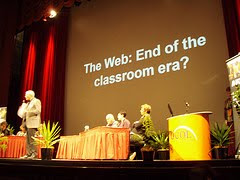
“If people knew how hard I had to work to gain my mastery, it would not seem so wonderful at all” Michelangelo
This post describes a session given by Colin Cox at the eFest meets Teaching and Learning 2009 on October 1st 2009. It focussed on talent, motivation and myelin! It posed the questions: do you do what you do because you have natural talent? Mystery about how to people have talent, what is it, and where does it come from?
A session that explored what the components that make talent and how you ‘grow’ talent. It was a quite interactive session, which involved for example speaking to the person sitting next to you and asking what they felt talent is, and then collecting some of the responses from the audience verbally. Only about 30 seconds per question was given, but the replies indicated that it was just long enough for people to formulate ideas and replies. The answers indicated quite a cross-section of opinions around the subject of talent, its source, and how/if it can be enhanced. Some key ways that were seen as effective ways of enhancing the potential of learners in education, including coaching, self-belief, practice, mentoring, commitment, opportunity.
Some examples of people with talent were Lance Armstrong, Tiger Woods, Jerry Rice, Shane Cameron, and this then moved to a discussion of ‘nature or nurture’. If it isn’t nature then the conclusion was that it would exclude a lot of people. The question was also raised about excellence or mastery in any endeavour and if it was about innate talent, IQ, memory, physical prowess, motivation, practice or a combination.
The example of Tiger Woods was unpicked, and the notion of the fact it was hard work and role models that made the difference as opposed to genetics (although genetic potential does determine height, weight, and muscle mass). By his first major competition at the age of 17 he had already been practising golf since he was 1 ½ years of age.
The next area that was explored was short-term memory (cited the 1978 Carnegie Mellon University study). Cox role=played the part of SF who was able to remember 22 digits after hearing them only seconds before – 1 per second. The amount of effort was physical and emotional. With 250 hours of practice SF was able to recite back 88 digits having only heard them once – 1 per second. The short-term memory is something that can be expanded and extended with practice. The records are now being broken regularly, from 102, to 3 card decks (52 cards in a deck). It was emphasised that SF had average ability.
IQ was the next subject to be put under the spotlight. A study around sales people and horse racing was cited, and looked at who was the most successful, given the information that they have, at predicting results. IQ was not a predictor of success – the lawyer (IQ 118) was not as successful as a construction worker (IQ 85), with the construction worker using more complex formulae, and a success rate double that of the lawyer.
Cox gave an overview of the ‘Myelin secret’ – it’s not about neurons and synapses it’s about Myelin, the neuron insulator. The more you do an activity, the more it insulates the neuron, which takes a neuron from basic functionality to ‘super’ functionality that enables quick responses, thinking and interconnections. Neurons are stimulated by outside actions and influences; the first time you do something neurons fire slowly and are relatively ‘uncoordinated’ – the more something is done, the more the myelin insulates the neurons, and the better the performance of the neuron. Einstein’s brain was the same size as the average person but it had a lot more white matter – myelin.
As an overview, Cox concluded with a discussion of:
1) passion; passion maximises talent because talent requires effort and time, and is not always fun; Where talent meets talent, the person becomes unstoppable. Initially, the passion is not there; there is the requirement for a role model who encourages people to try something. Once a person tries something and realises that they are quite good at something, then this can translate to passion that helps you overcome difficulties and hardships. It helps when the role model is also passionate.
2) practice; it is not any old practice that makes the difference, it is ‘perfect practice’. The elite don’t just practice, they do deliberate practice that is designed to improve performance, and helps the individual identify specific elements for improvement. What meaning has this for students? The comfort zone is not your friend! Life needs to include challenge, things that push you outside of your comfort zone – things you do not know how to do. However, the ‘panic zone’ is also a negative space where a person is pushed too far, which often results in an individual giving up and/or withdrawing. Each student has a different range of comfort, learning and panic zones, so learning experiences need to be tailored to the individual. Practice is the ‘mother’ of skills and includes observation, imitation and repetition. It includes focussed work that builds myelin. Anders Ericsson says the 10-year (10,000 hours) rule appears to be consistently accurate – i.e. it takes 10 years to master something, whether it is playing a musical instrument, playing a sport, excelling in a career.
3) Feedback is vital when you are practising.
A thought-provoking session, with a lot of application for education, and helping learners meet their potential.











